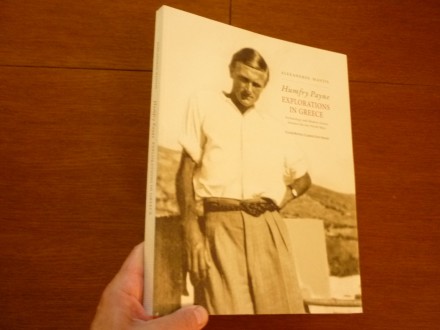EXPLORATIONS IN GREECE
| Cena: |
| Želi ovaj predmet: | 2 |
| Stanje: | Polovan bez oštećenja |
| Garancija: | Ne |
| Isporuka: | Pošta Post Express Lično preuzimanje Organizovani transport: 210 din |
| Plaćanje: | Tekući račun (pre slanja) PostNet (pre slanja) Lično |
| Grad: |
Smederevska Palanka, Smederevska Palanka |
ISBN: Ostalo
Godina izdanja: 2009.
Jezik: Engleski
Autor: Strani
Alexandros G. Mantēs, Humfry Payne EXPLORATIONS IN GREECE
Archaeology and Modern Greece between the two World Wars
A4 format, 174 ilustrovanih strana.
Odlično očuvana.
Humfry Gilbert Garth Payne (1902-1936) was a British archaeologist. He was born in Wendover, in the county of Buckinghamshire, on 19 February 1902. He was the only son of Edward John Payne (1844-1904), an anthropologist and historian of the New World, while one of his ancestors was Sir Richard Payne-Knight, a famous collector of antiquities and opponent of Lord Elgin. Payne’s early education was at Westminster School. He went on from there to Christ Church College, Oxford, with an open classical scholarship. Among his teachers was a legendary figure in British archaeology, John Beazley. In 1926 he married the journalist Dilys Powell. During the years 1927-1929 Payne spent summer archaeological excavation seasons on Crete. In June 1929 he excavated at Eleutherna (on Crete). From the autumn of 1929 until his death in 1936 he was the director of the British School at Athens. During these years he excavated at Perachora, near Corinth, where he discovered the sanctuaries of Hera Akraia and Limenia. His career came to an early end when at the age of 34 he died from an infection of staphylococcus in the Evangelismos Hospital in Athens, near the British School at Athens. He is buried in the cemetery of Agios Georgios at Mycenae.
Contents
Foreword [11]
A Tribute [12]
Preface [13]
The ‘Adonais’ of British archaeology [17]
The ‘days of the great walkers’ (1924-1926) [21]
Studying the beginnings of ancient Greek art. Payne’s first publications and the appearance of Necrocorinthia (1925-1928) [25]
In search of an untouched archaic site. His excavation at Eleutherna (10 June – 11 July 1929) [37]
The ‘Geometric man’. Payne’s physical characteristics [43]
His term as Director of the British School at Athens (1929-1936) [46]
The ‘chance of a lifetime’. Payne’s excavations at the Heraion of Perachora (1930-1933) [49]
His scholarly work during his term as Director of the British School [65]
Return to Crete. His excavations at the cemetery of Fortetsa (1933-1935) [70]
‘Plaster waist on marble hips’. Payne’s researches and discoveries at the Acropolis Museum [72]
‘Mourn not for Adonais’. The last act of the drama [89]
Epilogue [95]
Notes [97]
Appendices [107]
I. Obituaries [109]
II. List of his publications [122]
III. Critical reviews of his publications [123]
IV. Texts on his work [143]
V. Plates [151]
Grčka, arheologija, Hemfri Pejn...
K
Sva komunikacija se obavlja putem Kupindo poruka.
Pod `organizovanim transportom` smatram preporučenu tiskovinu ili paket (kada su kompleti i teže knjige).
Običnu tiskovinu ne šaljem jer nemam dokaz o slanju.
Novi cenovnik Pošte za preporučenu tiskovinu:
- 100g - 250g - 190 dinara
- 250g - 500g - 210 dinara
- 500g - 1kg - 230 dinara
- 1kg - 2kg - 270 dinara
Molim kupce iz inostranstva da me pre kupovine kontaktiraju porukom kako bismo se dogovorili oko uslova uplaćivanja i slanja.
Besplatna poštarina se ne odnosi na slanje u inostranstvo.
Pogledajte i ponudu na:
https://www.kupindo.com/pretraga.php?Grupa=1&Pretraga=&CeleReci=0&UNaslovu=0&Prodavac=anarh&Okrug=-1&Opstina=-1&CenaOd=&CenaDo=&submit=tra%C5%BEi
Ukoliko i tamo nešto pronađete, platićete preko istog računa i uštedeti na poštarini.
Predmet: 75570725















